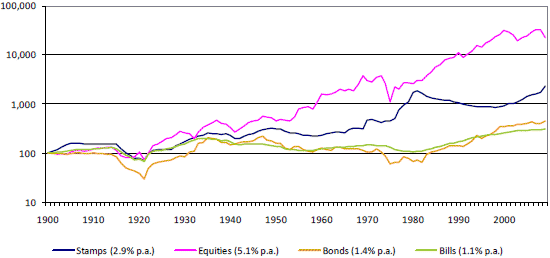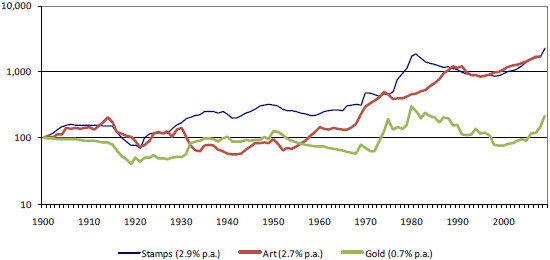Do stamps provide a good return compared to equities? Can investors use stamps to hedge against inflation? In the February 2010 version of their paper entitled “Ex Post: The Investment Performance of Collectible Stamps”, Elroy Dimson and Christophe Spaenjers investigate the returns on British collectible postage stamps over the long term. Using Stanley Gibbons stamp catalog prices to construct a value-weighted British stamp price index/returns and returns for other asset classes over the period 1900-2008, they conclude that:
- Stamps generate a nominal (real) annualized return of 7.0% (2.9%) over the entire sample period, worse than equities, better than bonds and comparable to art (see the charts below). The volatility of stamp prices approaches that of equities.
- Nominal stamp prices decline by 1% or more in only four years, but are flat over extended intervals (1949-1957 and 1983-1994). Strongest nominal gains occur at the start of the 20th century, from the mid-1960s through the 1970s and during the 2000s.
- The 1910s, the 1950s and 1981-1994 are extended intervals of real stamp depreciation. The intervals of strongest real appreciation are the second half of the 1970s and 2003-2008.
- Over the entire sample period, the 2.7%annualized real return for art is close to that for stamps. There is a boom in stamps (but not art) in the 1970s, and a boom in art (but not stamps) in the 1980s.
- While the annualized 0.7% real return for gold over the entire sample period is much less than that for stamps, price patterns for gold and stamps are similar.
- Equity market movements affect stamp prices, but the systematic risk (beta) of stamps is low. Stamps are a hedge against expected inflation and perhaps, like gold, a partial hedge against unexpected inflation.
- After accounting for holding periods and reasonable trading frictions, stamps may rival equities for the average investor in terms of realized performance.
The following charts, taken from the paper, plot the normalized real cumulative returns on stamps and financial assets (upper chart) and stamps and real assets (lower chart) over the entire 1900-2008 sample period. British stamps have underperformed British equities, matched art and outperformed British government bonds/bills and gold over the long term.


In summary, evidence indicates that stamps probably underperform stocks, beat bonds and gold and tie art over the long run, with a return pattern somewhat like that of gold.